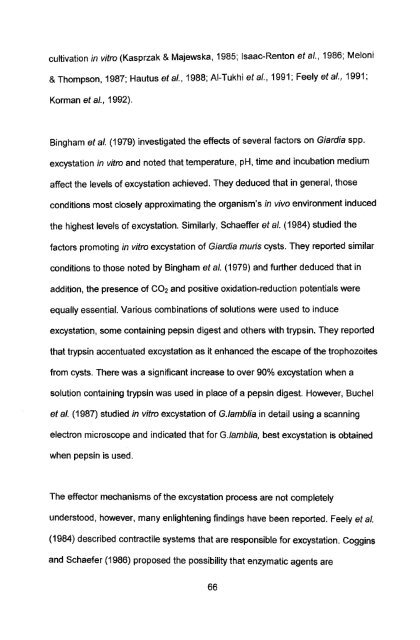in vitro culture and isoenzyme analysis of giardia lamblia
in vitro culture and isoenzyme analysis of giardia lamblia
in vitro culture and isoenzyme analysis of giardia lamblia
You also want an ePaper? Increase the reach of your titles
YUMPU automatically turns print PDFs into web optimized ePapers that Google loves.
cultivation <strong>in</strong> <strong>vitro</strong> (Kasprzak & Majewska, 1985; Isaac-Renton et al., 1986; Meloni<br />
& Thompson, 1987; Hautus et al., 1988; AI-Tukhi et al., 1991; Feely et al., 1991;<br />
Korman et al., 1992).<br />
B<strong>in</strong>gham et al. (1979) <strong>in</strong>vestigated the effects <strong>of</strong> several factors on Giardia spp.<br />
excystation <strong>in</strong> <strong>vitro</strong> <strong>and</strong> noted that temperature, pH, time <strong>and</strong> <strong>in</strong>cubation medium<br />
affect the levels <strong>of</strong> excystation achieved. They deduced that <strong>in</strong> general, those<br />
conditions most closely approximat<strong>in</strong>g the organism's <strong>in</strong> vivo environment <strong>in</strong>duced<br />
the highest levels <strong>of</strong> excystation. Similarly, Schaeffer et al. (1984) studied the<br />
factors promot<strong>in</strong>g <strong>in</strong> <strong>vitro</strong> excystation <strong>of</strong> Giardia muris cysts. They reported similar<br />
conditions to those noted by B<strong>in</strong>gham et al. (1979) <strong>and</strong> further deduced that <strong>in</strong><br />
addition, the presence <strong>of</strong> C02 <strong>and</strong> positive oxidation-reduction potentia Is were<br />
equally essential. Various comb<strong>in</strong>ations <strong>of</strong> solutions were used to <strong>in</strong>duce<br />
excystation, some conta<strong>in</strong><strong>in</strong>g peps<strong>in</strong> digest <strong>and</strong> others with tryps<strong>in</strong>. They reported<br />
that tryps<strong>in</strong> accentuated excystation as it enhanced the escape <strong>of</strong> the trophozoites<br />
from cysts. There was a significant <strong>in</strong>crease to over 90% excystation when a<br />
solution conta<strong>in</strong><strong>in</strong>g tryps<strong>in</strong> was used <strong>in</strong> place <strong>of</strong> a peps<strong>in</strong> digest. However, Buchel<br />
et al. (1987) studied <strong>in</strong> <strong>vitro</strong> excystation <strong>of</strong> G.<strong>lamblia</strong> <strong>in</strong> detail us<strong>in</strong>g a scann<strong>in</strong>g<br />
electron microscope <strong>and</strong> <strong>in</strong>dicated that for G./amb/ia, best excystation is obta<strong>in</strong>ed<br />
when peps<strong>in</strong> is used.<br />
The effector mechanisms <strong>of</strong> the excystation process are not completely<br />
understood, however, many enlighten<strong>in</strong>g f<strong>in</strong>d<strong>in</strong>gs have been reported. Feely et al.<br />
(1984) described contractile systems that are responsible for excystation. Cogg<strong>in</strong>s<br />
<strong>and</strong> Schaefer (1986) proposed the possibility that enzymatic agents are<br />
66
















